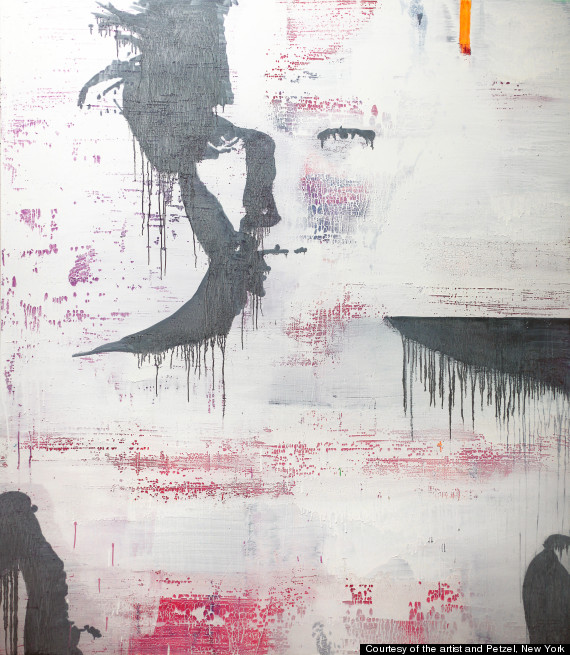At first glance, the multi-media artworks of German artist Dirk Skreber seems to have one thing in common -- chaos. From crashed vehicles to gliding drones to scuba divers armed with anti-matter guns, his paintings and installations showcase imagery often associated with war, destruction and death. Yet the artist's masterful technique using vibrant and detailed strokes that border on the realm of hyper-realism evoke a sense of serenity and awe, or as the artist puts it, "euphoria." The mounting contradictions are something Skreber relishes, a melding of calm, painterly elements with striking, controversial tableaus that persist in all of his artworks.
The subject matter of his newest exhibit, which opens at Petzel Gallery this month, is perhaps the most intriguing example of his contradictory nature. Titled "Pain(t)ology and Other Trials," the collection features paintings based on the infamous photographs of the Pentagon after 9/11, which, according to some conspiracy theorists, gives credence to the notion that the event was enacted from within the US defense base. From these contentious images of the Pentagon, Skreber moves to the Russian courtroom, reconstructing the iconic cage used to house the three members of Pussy Riot during their hugely-publicized legal showdown and meteoric rise to fame. In an interview with Skreber conducted earlier this month, the artist explains his aesthetic fascination with drones, cages and the power of beautiful women. (Scroll down for photos.)

A selection from Dirk Skreber's "Pain(t)ology" exhibit at Petzel Gallery
HP: The name of your upcoming exhibit at Petzel is distinct: “Pain(t)ology and Other Trials.” Where does this title come from?
DS: I love word games. Many years ago, I had a title called "Paint Spotting," which of course comes from Trainspotting. But ["Pain(t)ology"] came from the fact that I wasn't that much into painting for a couple of years. And for this exhibition, and over the last two years, I began changing a lot of paintings I had done before. For me, this was a way back into painting. And that became "Pain(t)ology." It sounds scientific, which I like. But also, it doesn't exist; "paintology" doesn't exist.
HP: Tell us about some of the exhibit's images. Many of them are associated with catastrophe and war -- explosions, drones, uranium enrichment sites. Why?
DS: Well, for some of these paintings I used material from 12 years ago of the attack on the Pentagon. I had found images on the internet of the attack, and thought that they were so important. This material shows a place where the wall is falling off and looks into a slightly destroyed office. I've heard this imagery is an indicator for many things but not for a plane crashing into a building. To me, that makes these images even more interesting. Objectively, they are very tempting though because they look exciting with all these shapes and cables hanging out, and there is a whole air conditioning unit sticking out with nozzles.
HP: How did you come across the images?
DS: I came across them because I was reading Christopher Bollyn's "Solving 9-11." I don't want to get too deep, but it inspired me. I saw the images again and again and I thought, I have to do something.
HP: What inspired the focus on drones in your work?
DS: For some reason, drones to me are so interesting because the surface of a drone is -- compared to to other airplanes -- so sleek and kind of innocent. Sculpture-like with practically no windows. It's blind. And I was always looking at drones as a painter. Once it is settled you are more or less figurative, you never look at things without a painter's eye. If I see a drone, I see something that is easy to paint. So, it is interesting for two reasons. First, because of its approach to the world, as un unmanned flying machine, silently crossing the planet. On the other hand, it looks so tempting to quickly paint. It's like molding, like you do with sculpture.
But I became interested in drones after having this one landscape in mind. When I finished it was so beautiful, but kind of empty and a little boring. I was hustling and I needed something, and then the idea of a drone came to me. A silent, beautiful landscape, but on the other side is this controversial object, on the way to kill.
HP: Is the controversy behind drones something you want to bring out?
DS: It's always in the painting. I can't delete this purpose, you know. And I love sharp contradictions. To me it's very interesting to deal with a tight space with hard contradictions. And that's happening here.
HP: Speaking of contradictions, you also have a sculptural installation on display titled PRC, a reconstruction of the cage used in the Pussy Riot trial. It showcases an object that was on the one hand a symbol of Russia's attempts to suppress freedom of expression and on the other hand the stage upon which these three women became famous.
DS: Exactly. The whole things is very contradictory. The cage itself is so weird in the courtroom. The craftsmanship is very complicated. I had a long time to figure out how to build it with all the steps and details. The people in Russia had to put a lot of attention into it. It's a beautiful piece of furniture on its own. But in the courtroom it makes sure people don't run away, which is kind of ridiculous because who would run away with so many armed people around?
In a different group of paintings, I show partially topless, beautiful models, and the whole time I was making it, I was thinking about what they meant other than that they are beautiful -- that I am a man and straight. After watching Pussy Riot and other groups like Femen in Ukraine, who are flashing and demonstrating in public, this is way more of what I mean. This matches my approach of trying to depict the power of not only beautiful women but of women in general, separate from men. Our powers are different. We have a loud voice and can punch people, and maybe we can be powerful in society but it often goes the wrong way.
HP: Are you talking about sexuality? Sexual power?
DS: Yes and no. It's in there of course, but I think the position of Femen is very complicated. Most of them are not ugly -- they are beautiful women and they flash in public. But it's not exactly anti-sexuality, it's against sexism. On the other hand, with sexuality, they are using just that.
HP: Beyond these controversial subjects apparent in your recent exhibits, what or who inspired your early work as a painter?
I would say I had a great moment when I was 21 in Dusseldorf in front of the "White Flag" work by Jasper Johns. At this time I was also reading [Wassily] Kandinksy, who I still think wrote two of the most amazing books about essential rules in paintng and drawing. And then there was music. I was listening to new classical music -- Edgard Varèse because of Frank Zappa, and [Bela] Bartok. And I'm still listening to [Gyorgy] Ligeti.
Dirk Skreber's "Pain(t)ology and Other Trials" opens at Petzel Gallery on February 21 and will run until March 30, 2013.

